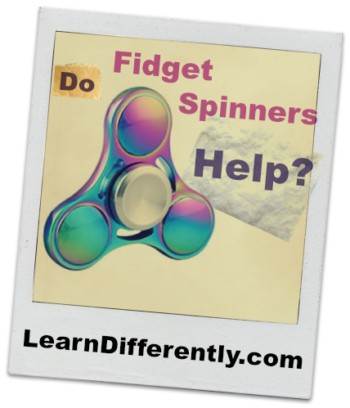Do Fidget Spinners Help? 5 Rules for Finding Fidgets To Improve Focus

By Kathy Kuhl
For some people, sitting still is so hard that they can’t sit still and listen, think, or do much else. These folks need something to do with their hands to help them keep still and focus. Some people fiddle with a paperclip, click a ballpoint pen, jiggle coins in a pocket, or spin a ring around a finger, for example.
What’s a fidget? A fidget is an object you move in your hand to help you focus and sit still. Breaking the rule of how to write a definition, I like to say a good fidget is “something you fidget with to keep you from fidgeting.”
What makes a good fidget?
Here are some guidelines to keep in mind when thinking about fidgets.

- A good fidget improves your attention. It’s not so engaging and cool that it demands all your attention. It just burns a little of your excess energy, satisfying your need to focus on several things at once. An effective fidget must not absorb all your attention. Video and video games can do that, and no one has ever claimed they improve attention. They just trap your attention, and make it harder to step back and remember what you are supposed to be doing.
- A good fidget for you may not work for me, and vice versa. One mother I interviewed for Homeschooling Your Struggling Learner reported that her son remembered more of his history lesson if she let him play with Legos® as she read it aloud to him. But I think that if I’d allowed Legos® during our homeschool time, my son would have quickly become absorbed in creating his own story.
- A good fidget also doesn’t drive other people crazy. Jingling coins in my pocket may help me focus, but if it bugs my little sister, husband, or neighbor, then I’m not being a good neighbor. A squeeze ball may soothe me and help me listen, but if I drop it and it rolls across the floor six times during the math lesson, I have surely distracted other people—and not been kind to the homeschooling parent or teacher.
- A good fidget is not very expensive. If I am distractible enough to need a fidget, I might lose it. (Please don’t ask my mother how many things I lost as a child.) So I wouldn’t buy an expensive fidget.
- If there are small children in the house, the fidget should not be a choking hazard. Distractible people who need fidgets may accidentally leave them where little ones can reach.

I love magnetic ball kits like these listed below. They are fascinating, creative toys–but they can cause a lethal blockage of the intestines if swallowed.
NOT FOR KIDS WHO PUT THINGS IN THEIR MOUTHS
How do you know a fidget is helping?
Not because it makes you feel peaceful or tranquilized. Many alluring toys with repetitive motion can do that without necessarily improving focus.
Try this simple test to see if a particular fidget is helping your child or teen. Let them handle the fidget as you read aloud some text to them. It could be science, history, or literature. (Choose a book that is not riveting—not their favorite author, not a favorite subject—and not something they already know.) Pause to ask questions throughout the reading to see how well the fidgeter is paying attention.
Try this for several days with the fidget you are testing and without, with the same chapter book, but not rereading the section they heard yesterday.
What about fidget spinners?
Spinners might help some people focus, but they seem to fail the first test, since many people say they are mesmerizing rather than enabling focus. News reports reveal that many teachers find them annoying, so they fail the third test. Based on my shopping yesterday, I think they are often too expensive, as well.
Complicating the matter, fidget spinners are a fad. So your children may think they want one because their friends have them, collect them, and talk about them. These toys appeal to the hand and the eye. This doesn’t necessarily make them a good fidget for the distractible child.
Other Fidgets
I’ve been a long-time fan of the Tangle Jr, a plastic loop of sturdy, smoothly curving links that you can wrap around your fingers like a coiling phone cord. They also come in metallic, textured, and…
and even “fuzzy” finishes, textured like a Koosh Ball, which isn’t a bad fidget, either.
Fidget cubes & Spinner Rings
You’ve probably heard of the fidget cube and spinner rings. If not, below are a few examples of the many varieties.
Fidget cubes were originally developed by Antsy Labs in a Kickstarter campaign in 2016. During production delays, many imitations appeared. These cubes are about an inch and a half across. Each side has a different toy to fiddle with. One has a toggle switch. Another side has five buttons, three of which click, and two of which are silent–so useful for using in class or at meetings. Another side has gears to twirl, another has a large round raised button to wobble, a bit like a joystick, and so on. Many knockoffs have been made, some of poor quality. You want a fidget cube with buttons that move smoothly and at least some sides that are silent so you can use it in public without disturbing others. Here’s the original from Antsy Labs, and below, one of many others on Amazon.
Spinner rings come in many colors and are a more discreet way to keep a fidget with you. Each ring has a second ring embedded on a wide groove on top. You can flick the upper ring to spin around the base ring. Here’s one:
A fidget doesn’t have to be designed as a fidget
When I was in middle school, rings with secret compartments were popular, like this one. I remember flicking mine open and shut while I listened in class.
Even Cheaper Fidgets
-
- Squeeze balls can work for adults, but it’s tempting for kids to toss them, and they can roll away, bounce, and interrupt lessons.
- Hacky sacks don’t roll away like squeeze balls do. You can by one or make your own, as one homeschooler in Cincinnati showed me. She had filled the toe of an old pair of panty hose with rice, and knotted it off. Then she crocheted a cover to surround it. See below for instructions for a similar project.
- Incidentally, knitting and crocheting can be a great way to keep hands occupied, so minds can focus.
- Artist’s eraser, also called kneaded eraser. Usually gray, these erasers are moldable. And in a setting where toys are not allowed, students can truthfully say, “It’s an eraser.”
- Make your own squeeze ball using only balloons, a funnel, and flour or rice: Slide a balloon inside another balloon, leaving the opening of the inner balloon just at the outside balloon’s opening. With a funnel, fill the inner balloon with flour or rice. Knot them closed. See the video below for directions for a fancier “ninja” version.
- A smooth, polished stone doesn’t make a bad fidget, if it feels good in your hand. So-called “worry stones” (also called thumb stones) have an oval indentation to run your thumb around. It’s not magical, but it can can be soothing.
Other tools for movement to improve focus
Fidgets help hands keep occupied. But other strategies for distractible people include sitting on exercise balls or squishy air cushions, or using a standing desk. Also, you can stretch a bungee cord across the front legs of a chair, then sit and press your calves against the cord.
Everything trains your brain. What are you training for?
What do you want to train your brain and your children’s brains to be good at?
Violinists develop the parts of their brain that control hands and discriminate tones. London cabbies grow the connections in the hypothalamus that build their mental street map of London. I remind myself that I don’t really want to waste much of my brain on getting really good at Word Wipe, or whatever word games are tempting me today.
Occupational therapist Victoria Prooday writes how fidgets, iPads, and video games give us instant gratification, so we grow to crave more high levels of stimulation. It becomes harder to read or listen to adults because kids have just had twenty-minutes of instant flashy rewards from our electronics. But real life isn’t about instant rewards. It’s about showing up to work on time, working steadily, caring for family daily, and honing skills with consistent practice.
Resources
- YouTube instructions on how to make a hacky sack, or footbag as this instructor calls it. She doesn’t line hers with hose, but she crochets tightly with a small hook to keep the rice inside.
- Make your own Ninja stress balls with this YouTube video.
- Victoria Prooday’s excellent article on why and how to help our children learn delayed gratification.
- For more on the proper use of fidgets, see Cindy Goodrich’s article here.
- Want to learn about the research on fidgets and read practical suggestions on finding the right fidget for you or your student? Roland Rotz, Ph.D. and Sarah D. Wright have written a whole book on it: Fidget to Focus: Outwit Your Boredom: Sensory Strategies for Living with ADD.
What are your favorite fidgets? Please answer in the comments section below. Thank you.









